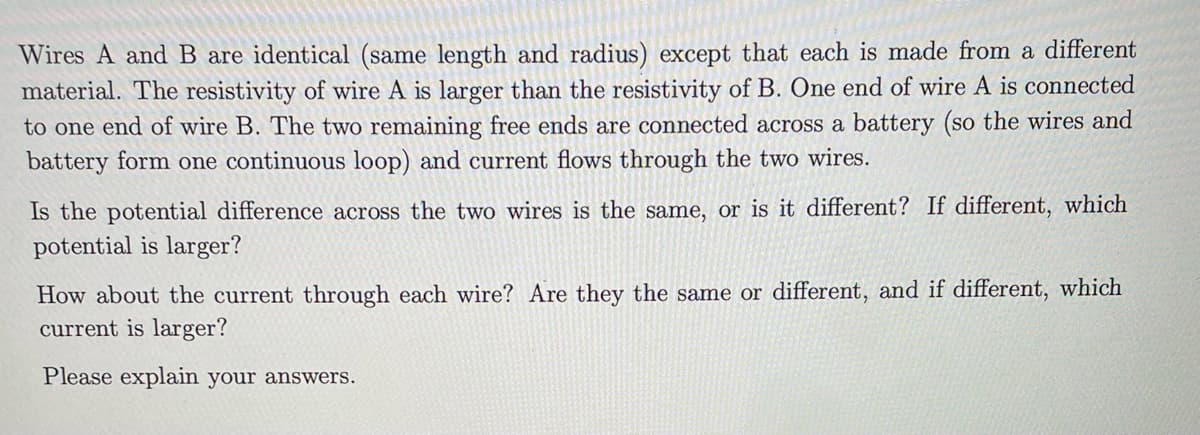Wires A and B are identical (same length and radius) except that each is made from a different material. The resistivity of wire A is larger than the resistivity of B. One end of wire A is connected to one end of wire B. The two remaining free ends are connected across a battery (so the wires and battery form one continuous loop) and current flows through the two wires. Is the potential difference across the two wires is the same, or is it different? If different, which potential is larger? How about the current through each wire? Are they the same or different, and if different, which current is larger? Please explain your answers. 22
Wires A and B are identical (same length and radius) except that each is made from a different material. The resistivity of wire A is larger than the resistivity of B. One end of wire A is connected to one end of wire B. The two remaining free ends are connected across a battery (so the wires and battery form one continuous loop) and current flows through the two wires. Is the potential difference across the two wires is the same, or is it different? If different, which potential is larger? How about the current through each wire? Are they the same or different, and if different, which current is larger? Please explain your answers. 22
Principles of Physics: A Calculus-Based Text
5th Edition
ISBN:9781133104261
Author:Raymond A. Serway, John W. Jewett
Publisher:Raymond A. Serway, John W. Jewett
Chapter21: Current And Direct Current Circuits
Section: Chapter Questions
Problem 63P
Related questions
Question

Transcribed Image Text:Wires A and B are identical (same length and radius) except that each is made from a different
material. The resistivity of wire A is larger than the resistivity of B. One end of wire A is connected
to one end of wire B. The two remaining free ends are connected across a battery (so the wires and
battery form one continuous loop) and current flows through the two wires.
Is the potential difference across the two wires is the same, or is it different? If different, which
potential is larger?
How about the current through each wire? Are they the same or different, and if different, which
current is larger?
Please explain your answers.
Expert Solution
This question has been solved!
Explore an expertly crafted, step-by-step solution for a thorough understanding of key concepts.
This is a popular solution!
Trending now
This is a popular solution!
Step by step
Solved in 4 steps with 4 images

Knowledge Booster
Learn more about
Need a deep-dive on the concept behind this application? Look no further. Learn more about this topic, physics and related others by exploring similar questions and additional content below.Recommended textbooks for you

Principles of Physics: A Calculus-Based Text
Physics
ISBN:
9781133104261
Author:
Raymond A. Serway, John W. Jewett
Publisher:
Cengage Learning

Principles of Physics: A Calculus-Based Text
Physics
ISBN:
9781133104261
Author:
Raymond A. Serway, John W. Jewett
Publisher:
Cengage Learning